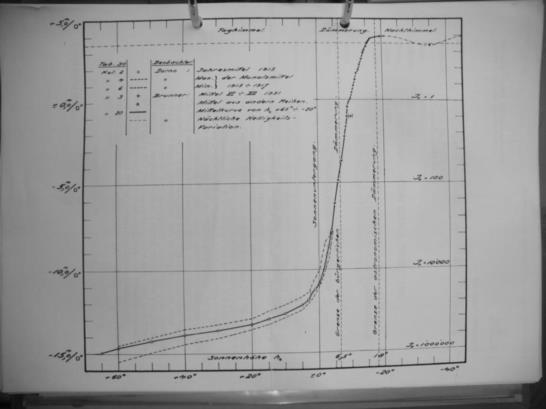
NavList:
A Community Devoted to the Preservation and Practice of Celestial Navigation and Other Methods of Traditional Wayfinding
From: Marcel Tschudin
Date: 2011 Aug 18, 19:45 +0300
Odd questions require sometimes not so obvious answers..
Thank you, Frank, for this link. It may eventually become useful one day in the future.
Just in case someone with an interest should come across this correspondence: Here what I found previously on measured brightness densities of the twilight sky.
Brunner, W., 1935: Beiträge zur Photometrie des Nachthimmels, Diss. Math. ETH Zürich, Nr. 847, Zürich 1935
(Attached you find a diagram taken from that thesis showing the zenith brightness density in magnitudes per squre degree for sun heights between +60 deg and -40 deg measured at Davos at about 1600 m a.s.l.) Brunner uses also measurements made by Dorno also measured in Davos. I was however not able to find that publication.
Koomen M. J. et al., 1952: Measurements of the Brightness of the Twilight Sky, Journal of the Optical Society of America, Vol. 42, No. 5, May 1952
(Abstract available here http://www.opticsinfobase.org/josa/abstract.cfm?uri=josa-42-5-353 )
Regarding the contrast difference for a point source to become visible. I think to remember having read somewhere that it would be about 0.1mag.
Marcel
Frank, Marcel -The reason I asked in the first place is that I have a friend who is heavily into astrology, yet, curiously enough, never looks at the sky at night (or day for that matter). I was discussing a method I use for memorizing the coordinates of a set of major navigational stars and she mentioned something about 'fixed star astrology' that seems to be a current mini-rage. Evidently there's some linkage of stars well off the ecliptic to planets and various traits. I asked her how the associations were done, imagining a number of possible projections onto the ecliptic.I cannot imagine a more cantankerous crowd than the astrologers as some dumped on Ptolemy's systems of astrology as being artificial. But I realized that his projections onto the ecliptic were natural if you associated them with heliacal risings, especially for observers within +/- 30 degrees of the equatorIn any case, for $400 you can purchase some software that does fixed star astrology, including heliacal risings. I believe the woman's name is Bernadette Brady.http://blog.californiapsychics.com/blog/2011/02/is-there-more-to-my-path-in-life-than-my-sun-sign.html/So, being the curious sort, I said to myself "hey, I can write some code to do that...."John H.--On Wed, Aug 17, 2011 at 7:41 PM, Frank Reed <FrankReed@historicalatlas.com> wrote:
Marcel,
When I did this recently, I just made up my own rules based on my own experiences spotting stars in twilight. The people who work on the open-source "Stellarium" project have clearly implemented some rules which may be founded on something more solid, so you could probably contact them --or just get a copy of the source code and find the rules they used. I don't imagine there are any reliable "scientific" studies of naked eye visibility of stars in twilight since weather conditions can change everything.
For atmospheric extinction near the horizon, I recommend this site:
http://www.icq.eps.harvard.edu/ICQExtinct.html.
See especially the tables at the bottom of the page.Speaking of weather and stars, in the past few days I've been amazed by the blackness of the sky around the nearly Full Moon here in Chicago even when there have been broken clouds at low altitudes. Normally there's a a gradual transition from medium to dark blue and then black extending five to ten degrees around the Moon. That blackness right up to one degree from the Moon is usually a sure sign of very dry air (also dust-free) at higher altitudes. I was able to see third magnitude stars just a few degrees from the Moon a few days ago, even with the light pollution of Chicago. That's really unusual, especially in August, when the skies are usually murky with haze.
-FER
----------------------------------------------------------------
NavList message boards and member settings: www.fer3.com/NavList
Members may optionally receive posts by email.
To cancel email delivery, send a message to NoMail[at]fer3.com
----------------------------------------------------------------
Keeping up with the grind







